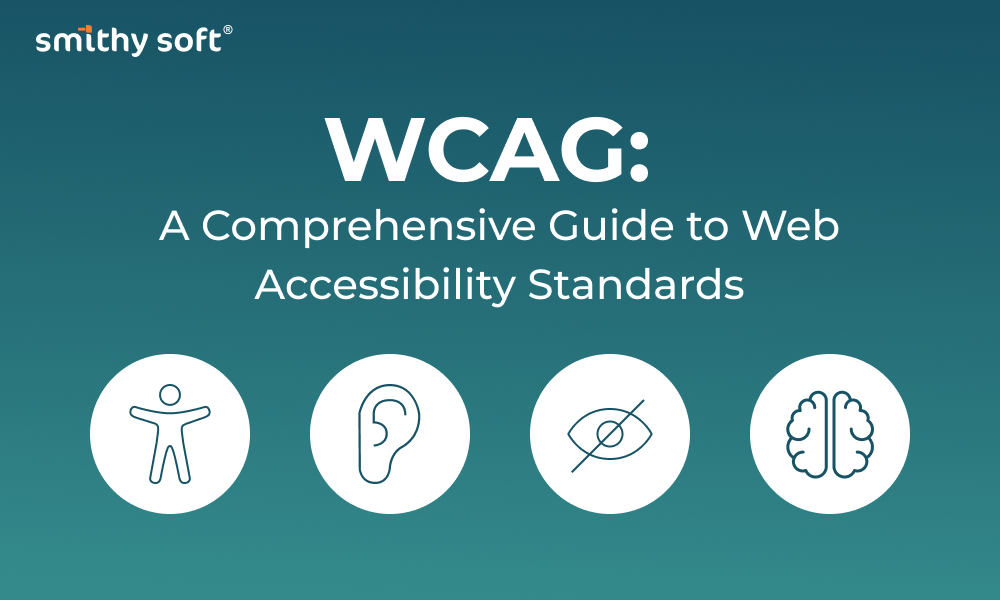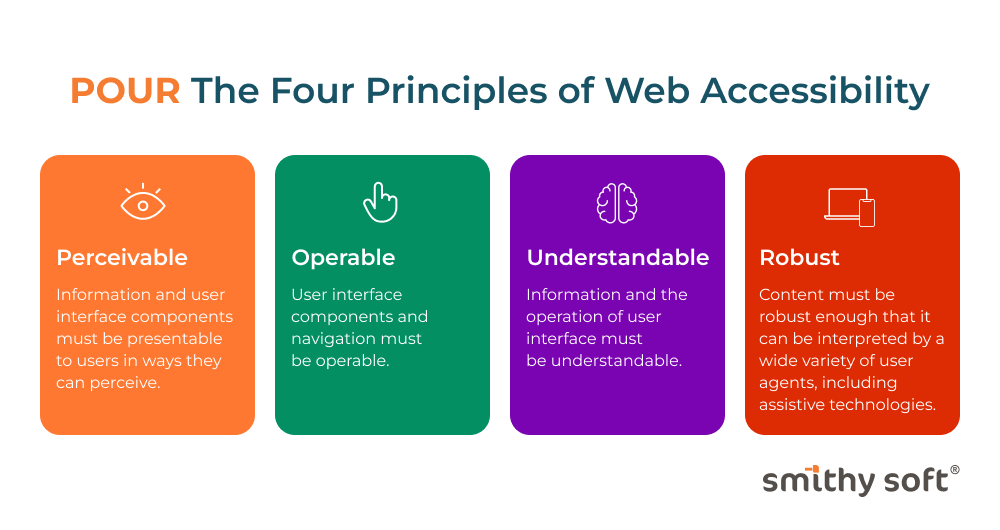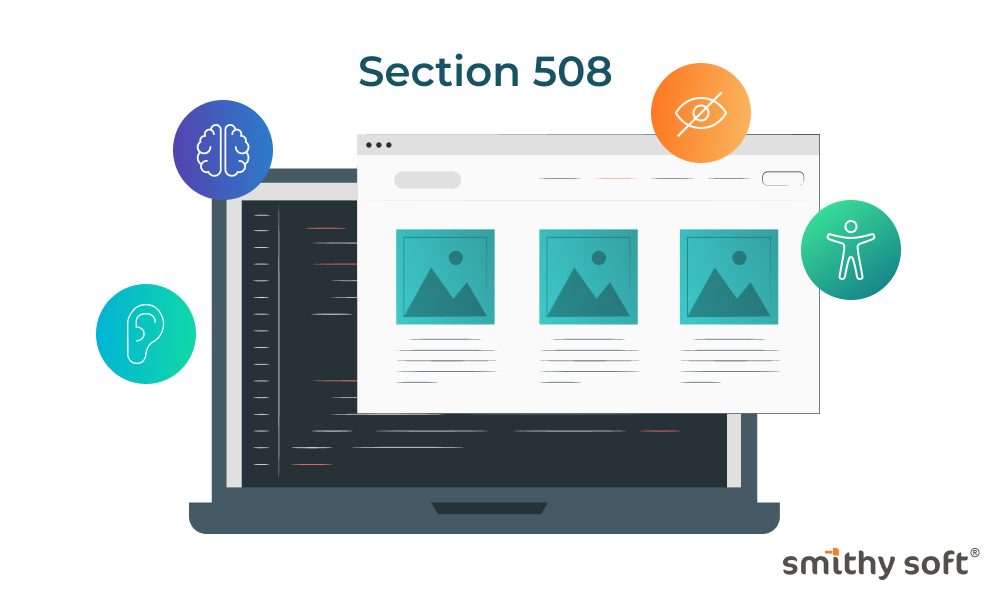WCAG: A Comprehensive Guide to Web Accessibility Standards

WCAG, which stands for Web Content Accessibility Guidelines, is the key to unlocking an inclusive digital experience that is accessible to all. These Web Content Accessibility Guidelines were developed by the World Wide Web Consortium. They are technical standards that help to make the digital world accessible to people with disabilities.
WCAG is not a law, but is a universal set of internationally accepted standards.
Many laws, including the Americans with Disabilities Act (ADA) and Section 508 of the Rehabilitation Act of 1973 in the U.S., the Accessibility for Ontarians with Disabilities Act (AODA) in Canada, and the European Accessibility Act (EAA) in Europe, require digital accessibility for compliance. WCAG conformance means your business is meeting WCAG standards, which have been adopted by U.S. and international anti-discrimination and accessibility legislation.
WCAG standards explain how to make digital services, websites and applications accessible to everyone, including users with disabilities of:
- vision (for people with severe visual impairments (blind), low vision (partially sighted) or colorblind);
- hearing (for people who are deaf or hard of hearing);
- speech and pronunciation;
- mobility (for people who have difficulty using a mouse or keyboard);
- thinking and understanding (for people with dyslexia, autism or learning disabilities).
So anyone who creates websites, mobile applications, programs, develops e-learning courses or creates any digital content shall understand and adhere to the WCAG standards.
If your digital product meets the WCAG requirements at a certain level (which we will explain in more details below), then it will be considered accessible from a legal point of view. This will broaden your audience to include groups that are too often underserved, and it will also help you to avoid legal action.
Who does create WCAG?
What’s special about WCAG is that it’s developed by a working group of stakeholders, including experts, regulators, academics, and businesspeople worldwide. The international community that collaborates on WCAG is called the Web Accessibility Initiative of the World Wide Web Consortium, or W3C. This group of staff, member organizations, and public members from all over the globe combine their expertise and energy to create these and other important standards for the web.
The WCAG technical documents are developed by the Accessibility Guidelines Working Group (AG WG) (formerly the Web Content Accessibility Guidelines Working Group), which is part of the World Wide Web Consortium (W3C) Web Accessibility Initiative (WAI).
WCAG Versions
WCAG exists in four versions: 1.0, 2.0, 2.1, and 2.2, which are regularly updated to keep up with changes in technology.
- WCAG 1.0: first published in May 1999, it primarily addressed HTML and was a fundamental step towards digital inclusion. This version is no longer recommended for use.
- WCAG 2.0: released on December 11, 2008, WCAG 2.0 was the most recent and widely accepted set of web accessibility guidelines available in a decade. This version expanded the scope to include new technologies such as mobile apps and mobile-friendly websites.
- WCAG 2.1: this version, released in June 2018, builds on the recommendations of version 2.0, includes information about new technologies (smartphones, tablets, smartwatches, etc.), and covers a wider range of accessibility needs. Updated on September 21, 2023.
- WCAG 2.2: is the most recent version of WCAG, published on October 05, 2023, with an update published on December 12, 2024. Adds nine new requirements after WCAG 2.1 and builds on WCAG 2.0 and 2.1, offering updates and new success criteria.
- WCAG 3.0: the fifth version is currently under development with no expected release date. It will have similar fundamental and specific accessibility requirements as WCAG 2, but will have a different structure, a different compliance model, and a broader scope.
WCAG 2.0, 2.1, and 2.2 are designed to be “backwards compatible”, which means content that conforms to WCAG 2.2 also conforms to WCAG 2.1 and WCAG 2.0. If you want to meet all the versions, you can use the WCAG 2.2 resources and you don’t need to bother looking at earlier versions.
WCAG 2.0, WCAG 2.1, and WCAG 2.2 are all existing standards. WCAG 2.2 does not deprecate or supersede WCAG 2.1, and WCAG 2.1 does not deprecate or supersede WCAG 2.0. W3C encourages you to use the most recent version of WCAG.
WCAG 2.0 is approved as an ISO standard: ISO/IEC 40500:2012. ISO/IEC 40500 is exactly the same as the original WCAG 2.0, which is introduced above along with supporting resources.
W3C submitted WCAG 2.2 to ISO. It will likely be after June 2025 before the ISO process is complete.
Layers of Guidance
The individuals and organizations that use WCAG vary widely and include Web designers and developers, policy makers, purchasing agents, teachers, and students.
In order to meet the varying needs of this audience, several layers of guidance are provided including overall principles, general guidelines, testable success criteria and a rich collection of sufficient techniques, advisory techniques, and documented common failures with examples, resource links and code.
- Principles - At the top are four principles that provide the foundation for Web accessibility: perceivable, operable, understandable, and robust.
- Guidelines - Under the principles are guidelines. The 13 guidelines provide the basic goals that authors should work toward in order to make content more accessible to users with different disabilities.
- Success Criteria - For each guideline, testable success criteria are provided to allow WCAG 2.1 to be used where requirements and conformance testing are necessary such as in design specification, purchasing, regulation, and contractual agreements. In order to meet the needs of different groups and different situations, three levels of conformance are defined: A (lowest), AA, and AAA (highest).
- Sufficient and Advisory Techniques - For each of the guidelines and success criteria in the WCAG 2.1 document itself, the working group has also documented a wide variety of techniques. The techniques are informative and fall into two categories: those that are sufficient for meeting the success criteria and those that are advisory
Main principles of WCAG
The guidelines and success criteria are organized around the following four principles, which lay the foundation necessary for anyone to access and use Web content.
IT offers, applications, and services must be designed to be barrier-free, i.e. Perceivable, Operable, Understandable, and Robust – the POUR principle.

- Perceivable - Information and user interface components must be presentable to users in ways they can perceive. This means that users must be able to perceive the information being presented (it can't be invisible to all of their senses).
- Operable - User interface components and navigation must be operable. This means that users must be able to operate the interface (the interface cannot require interaction that a user cannot perform).
- Understandable - Information and the operation of user interface must be understandable. This means that users must be able to understand the information as well as the operation of the user interface (the content or operation cannot be beyond their understanding).
- Robust - Content must be robust enough that it can be interpreted reliably by a wide variety of user agents, including assistive technologies. This means that users must be able to access the content as technologies advance (as technologies and user agents evolve, the content should remain accessible).
If any of these are not true, users with disabilities will not be able to use the Web.
Conformance Levels
WCAG 2.1 guidelines are categorized into three levels of conformance in order to meet the needs of different groups and different situations: A (lowest), AA (mid range), and AAA (highest).
Conformance at higher levels indicates conformance at lower levels. For example, by conforming to AA, a Web page meets both the A and AA conformance levels. Level A sets a minimum level of accessibility and does not achieve broad accessibility for many situations. For this reason, UC recommends AA conformance for all Web-based information.
The WCAG document does not recommend that Level AAA conformance be required as a general policy for entire sites because it is not possible to satisfy all Level AAA success criteria for some content.

- Level A: is the basic level of compliance that provides significant benefits that are applied to the broadest group of users. However, Level A compliance does not eliminate all the barriers that may impact the user experience.
Level A includes 32 success criteria aimed at benefiting both organizations and people with disabilities. It is designed to make it simple for organizations to update and comply, and easier for people with disabilities to access the website. Here are some examples of Level A success criteria for you to understand it a little better:
Success Criterion 1.1.1 – Non-text Content: All non-text content that is presented to the user has a text alternative that serves the equivalent purpose.
Success Criterion 1.3.2 – Meaning Sequence: Provide an alternative representation of the order of content without changing its meaning.
Success Criterion 1.4.1 – Use of Color: Avoid using only colors to convey information to users.
Success Criterion 1.4.2 – Audio Control: Ensure that there is a way to pause or stop the auto-playing audio that lasts for more than 3 seconds.
Success Criterion 2.3.1 – Three flashes or below threshold: Web pages must ensure that no content flashes more than three times a second, otherwise, it may trigger seizures for people with conditions like photosensitive epilepsy.
- Level AA: as the most common level of WCAG compliance, Level AA is widely adopted in regulations and referenced in regulatory negotiations. Achieving this criterion will make your website accessible to a greater number of users than simply meeting the criteria for Level A. This level is currently Recommended or Desired Accessibility.
Level AA incorporates all the success criteria from the previous level and introduces an additional 24 new criteria.Here are some examples of Level AA success criteria for you to understand it a little better:
Success Criterion 1.2.4 – Captions (Live): Live videos should have captions that are synchronized with the audio part of the video. Live captions will help to convey the information of the audio content to people who are deaf or hard of hearing.
Success Criterion 1.3.5 – Identify Input Purpose: Each input field should make it easier for all assistive devices to convey the information to their users.
Success Criterion 1.4.4 – Resize text: Ensure that all texts except captions and images of text can be resized up to 200 percent without losing functionality or visibility even without using Assistive Technology.
Success Criterion 1.4.5 – Images of text: Ensure that you provide text instead of images of text so that assistive technologies can easily convey the information to their users.
Success Criterion 1.4.10 – Reflow: Ensure that there is no loss of information and function while presenting the content which enables users to avoid scrolling in two dimensions.
- Level AAA: is the highest achievable level, covering the criteria for all three levels, and is considered ideal. However, meeting Level AAA is not realistic in all the scenarios.
This level adds 31 new success criteria in addition to levels A and AA, such as:
Success Criterion 1.2.6 – Sign Language (Pre-recorded): Provide the sign language interpretation to convey information of the audio content to people who are deaf or hard of hearing
Success Criterion 1.2.8 – Media Alternative (Pre-recorded): Time-based media should be provided with an alternative to make it accessible to individuals whose vision is too poor to reliably read captions and whose hearing is too poor to reliably hear dialogue and audio descriptions.
Success Criterion 1.4.8 – Visual Presentation: Provide multiple visual presentation options for blocks of texts to users
Success Criterion 2.2.3 – No Timing: Reduce the appearance of content that requires interactions with a set time limit.
Success Criterion 2.4.8 – Location: Provide users a way to align themselves within a set of web pages, a website, or a web application and find related information.
New success criteria in WCAG 2.2
2.4.11 Focus Not Obscured (Minimum) (AA)
When a user interface component receives keyboard focus, the component is not entirely hidden due to author-created content.
2.4.12 Focus Not Obscured (Enhanced) (AAA)
When a user interface component receives keyboard focus, no part of the component is hidden by author-created content.
2.4.13 Focus Appearance (AAA)
When the keyboard focus indicator is visible, an area of the focus indicator meets all the following:
- is at least as large as the area of a 2 CSS pixel thick perimeter of the unfocused component or sub-component, and
- has a contrast ratio of at least 3:1 between the same pixels in the focused and unfocused states.
Exceptions:
- The focus indicator is determined by the user agent and cannot be adjusted by the author, or
- The focus indicator and the indicator's background color are not modified by the author.
2.5.7 Dragging Movements (AA)
All functionality that uses a dragging movement for operation can be achieved by a single pointer without dragging, unless dragging is essential or the functionality is determined by the user agent and not modified by the author.
2.5.8 Target Size (Minimum) (AA)
The size of the target for pointer inputs is at least 24 by 24 CSS pixels, except when:
Spacing: Undersized targets (those less than 24 by 24 CSS pixels) are positioned so that if a 24 CSS pixel diameter circle is centered on the bounding box of each, the circles do not intersect another target or the circle for another undersized target;
Equivalent: The function can be achieved through a different control on the same page that meets this criterion;
Inline: The target is in a sentence or its size is otherwise constrained by the line-height of non-target text;
User Agent Control: The size of the target is determined by the user agent and is not modified by the author;
Essential: A particular presentation of the target is essential or is legally required for the information being conveyed.
3.2.6 Consistent Help (A)
If a web page contains any of the following help mechanisms, and those mechanisms are repeated on multiple web pages within a set of web pages, they occur in the same order relative to other page content, unless a change is initiated by the user:
- Human contact details;
- Human contact mechanism;
- Self-help option;
- A fully automated contact mechanism.
3.3.7 Redundant Entry (A)
Information previously entered by or provided to the user that is required to be entered again in the same process is either:
- auto-populated, or
- available for the user to select.
Except when:
- re-entering the information is essential,
- the information is required to ensure the security of the content, or
- previously entered information is no longer valid.
3.3.8 Accessible Authentication (Minimum) (AA)
A cognitive function test (such as remembering a password or solving a puzzle) is not required for any step in an authentication process unless that step provides at least one of the following:
- Alternative: Another authentication method that does not rely on a cognitive function test.
- Mechanism: A mechanism is available to assist the user in completing the cognitive function test.
- Object Recognition: The cognitive function test is to recognize objects.
- Personal Content: The cognitive function test is to identify non-text content the user provided to the website.
3.3.9 Accessible Authentication (Enhanced) (AAA)
A cognitive function test (such as remembering a password or solving a puzzle) is not required for any step in an authentication process unless that step provides at least one of the following:
- Alternative: Another authentication method that does not rely on a cognitive function test.
- Mechanism: A mechanism is available to assist the user in completing the cognitive function test.
How to Meet WCAG 2.2
A customizable quick reference to WCAG 2.2 that includes all of the guidelines, success criteria, and techniques for authors to use as they are developing and evaluating web content. This includes content from WCAG 2.0, 2.1, and 2.2, and can be filtered in many ways to help authors focus on relevant content: https://www.w3.org/WAI/WCAG22/quickref/
CONCLUSIONS
If the steps to achieve WCAG compliance seem complicated to you, don't despair. We'll help you figure it out – SmithySoft offers the full spectrum of Accessibility Analysis!


